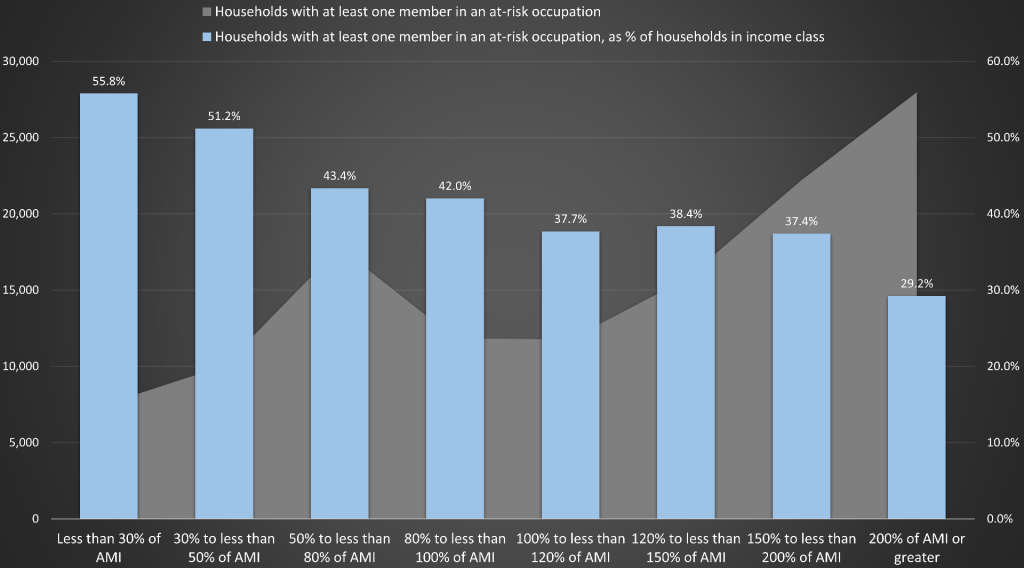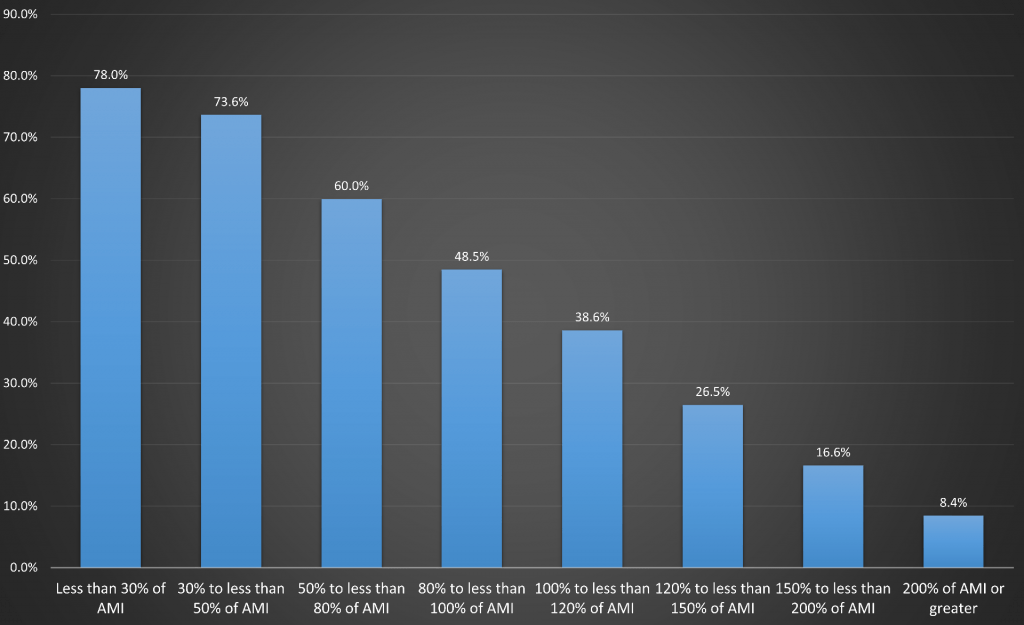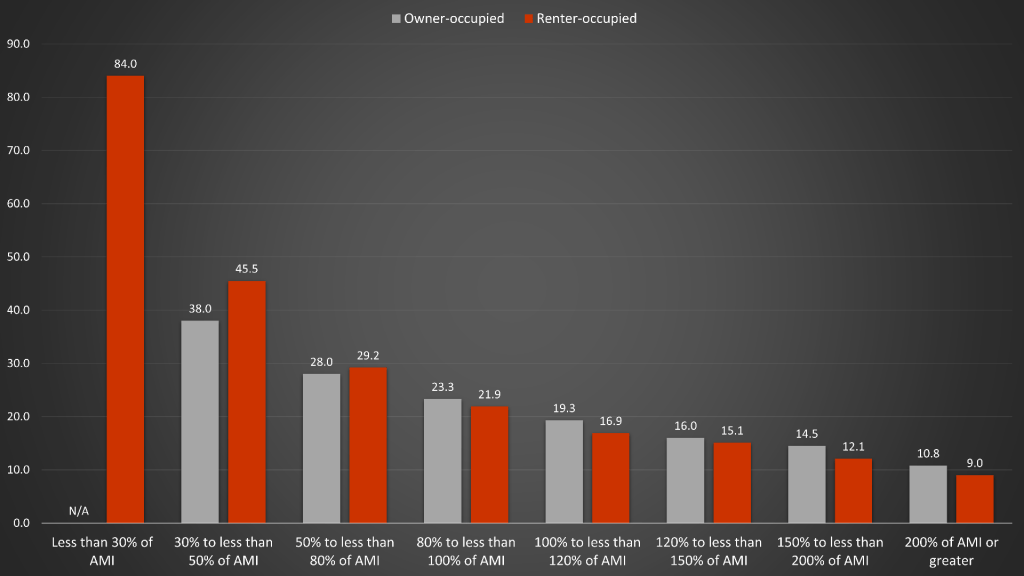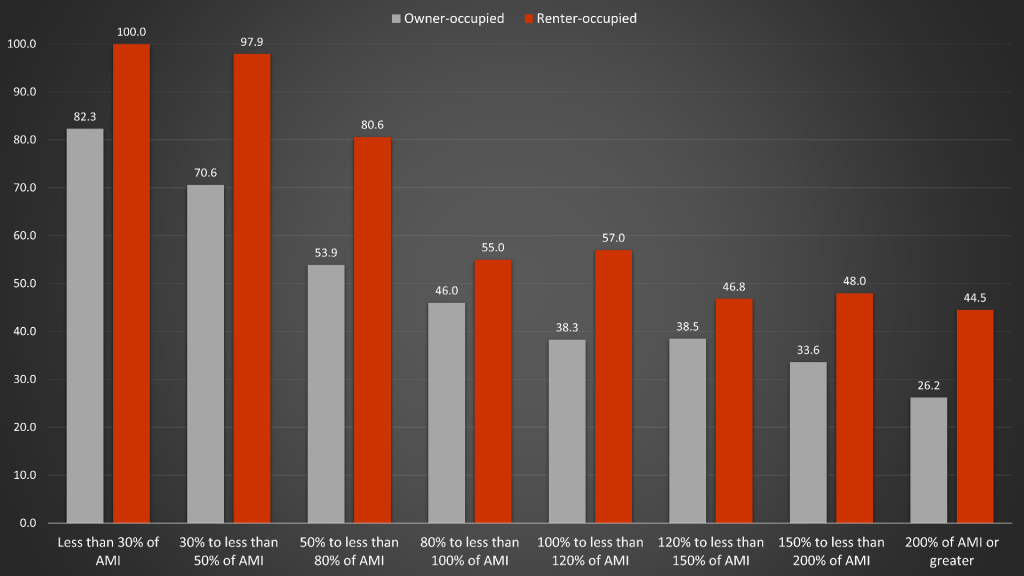Housing and Income Profile of Households At Risk of Mass COVID-19 Layoffs: Buffalo-Niagara Edition
19 May 2020
Since late March, we have been profiling New Yorkers who work in occupations most susceptible to COVID-related layoffs or workplace closures using NYU Furman Center data. With that data, we offered preliminary answers to broad questions about who is at risk, where at-risk workers live, and how many at-risk workers depend on employer-provided health care throughout New York State. More recently, we created a more in-depth housing and income profile of at-risk workers in the Rochester metropolitan area. This post replicates that latter effort for the Buffalo-Niagara metropolitan area, which consists of Erie and Niagara Counties in Western New York (WNY).
According to the most recent (2014-18) U.S. Census Bureau Five-Year American Community Survey (ACS), the Buffalo-Niagara metropolitan region is home to just under 580,000 civilian workers. Those workers are sorted into about 340,000 wage-earning households.
To delineate the universe of at-risk workers in Buffalo-Niagara using the Furman Center dataset, we first downloaded the Census Bureau’s Public Use Microdata Samples (PUMS) for the most recent ACS. Next, from the PUMS we selected out all civilian wage earners who live in households (as opposed to group quarters). We then joined the Furman Center job classifications to the PUMS data using detailed occupation codes. Finally, we applied Census Bureau-provided weights to the data to estimate the size of the at-risk workforce. Based on that process, we found that approximately 28% of workers – more than 150,000 individuals – in the Buffalo-Niagara metro area work in at-risk occupations. Those at-risk workers are distributed into roughly 125,000 households, or about 38% of all wage-earning households in the region.
Consistent with our statewide and Rochester-area findings, at-risk workers are disproportionately persons of color. As illustrated in the following table, persons of color make up just 17% of all workers in the region. But they account for nearly 22% of workers in at-risk jobs. The odds that such a disparity would occur by chance alone are less than one in 100 billion. African Americans are particularly overrepresented among at-risk workers: despite accounting for only 9.3% of the workforce, they hold 12.4% of at-risk jobs.
| Race | % of All Workers | % of At-Risk Workers |
| White (Not Hispanic or Latinx) | 83.0% | 78.0% |
| Black or African American (Not Hispanic or Latinx) | 9.3% | 12.4% |
| Hispanic or Latinx | 3.6% | 4.6% |
| Asian or Pacific Islander (Not Hispanic or Latinx) | 2.4% | 2.4% |
| Other Person of Color (Not Hispanic or Latinx) | 1.3% | 2.0% |
| American Indian or Alaska Native (Not Hispanic or Latinx) | 0.4% | 0.6% |
| All Persons of Color, Combined | 17.0% | 22.0% |
Intersecting with these disparities in at-risk work by race and ethnicity are alarming disparities by household income. More than half of the region’s lowest income households have at least one employed member in an at-risk occupation, compared to less than a third of the wealthiest households. More specifically, 53% of households with annual income below 50% of Buffalo-Niagara AMI (area median income, adjusted for household size) have at least one member in an at-risk occupation. For households earning more than double the regional AMI, that figure is only 29 percent.
Share of households with at least one member employed in an at-risk occupation, by household income
Concerning housing tenure, renter-occupied households are more likely to have members in at-risk occupations compared to owner-occupied households. Namely, renter-occupied households account for roughly 32% of all wage-earning households in Buffalo-Niagara but are 36% of households with at least one at-risk employee. Expressed another way, whereas just under 36% of all owner-occupied households have an at-risk employee, more than 42% of renter-occupied households contain at least one such worker. At low income levels, households with at-risk workers are much more likely to be renter-occupied than owner-occupied. In the most extreme case, nearly 80% of households with (1) income below 30% of Buffalo-Niagara AMI and (2) at least one at-risk employee, are renter-occupied.
Renter share of households with at least one member employed in an at-risk occupation, by household income
Among all wage-earning households in which at least one member works in an at-risk job, renter-occupied units are significantly more likely to be housing cost-burdened compared to owner-occupied units. More precisely, roughly 40% of renter-occupied households with at least one at-risk worker spend 30% or more of their gross monthly income on housing. The corresponding figure for owner-occupied households is less than 15 percent.
| Tenure for households with at least one at-risk worker | # of at-risk households | % housing cost-burdened* |
| Owner-occupied | 80,491 | 14.8% |
| Renter-occupied | 44,490 | 40.1% |
The driver of this disparity lies in the low end of the income distribution: low income renters (households with income below 80% of Buffalo-Niagara AMI) spend a greater share of their monthly income on housing costs relative to low income owners.
Median monthly housing cost to gross monthly income ratio for households with at least one at-risk member, by tenure
To recap, the data presented so far in this post suggest that, in the Buffalo-Niagara metro:
- Workers of color are disproportionately prone to work in jobs that are at risk of mass layoffs or workplace closures due to COVID-19;
- At-risk workers hail disproportionately from low income households; and
- Low income renter households with at-risk employees are particularly susceptible to devastating coronavirus-related economic consequences given their high propensity to be housing cost-burdened. That is, because these households spend such high fractions of their monthly income on housing – implying that they are living “paycheck to paycheck” – temporary or permanent job loss poses an immediate threat to housing security.
As if these trends were not concerning enough, the final graph presented below shows the median fraction of household income earned by members who are in at-risk jobs (broken out by housing tenure and household income). In other words, it shows the median percentage of household income that would be lost if all at-risk jobs were indeed eliminated due to COVID-19. At the bottom income levels – below 50% of the Buffalo-Niagara AMI – essentially all income for renter households comes from at-risk occupations. Furthermore, regardless of housing tenure, more than half of all income earned by households below the regional AMI comes from at-risk jobs. Thus, just as we found for Rochester, the most vulnerable households in Buffalo-Niagara – especially the ones shown above to already be living “paycheck to paycheck” – are the ones that are most likely to lose between half and all of their income due to COVID-19.
Median fraction of household income earned by members in at-risk occupations, by tenure
In light of these trends, there is a clear urgency to continue investing in emergency food and shelter funds. It will also be necessary to extend existing measures that temporarily suspend utility shutoffs and halt evictions. Finally, meaningful funds must be dedicated to building the capacity of the local mutual aid networks and other direct service providers that are on the frontlines delivering resources and support to households and families in need during this time of crisis. To contribute to specific efforts in the Buffalo-Niagara area, please visit the following websites:




